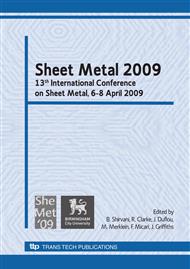p.449
p.459
p.467
p.473
p.481
p.493
p.503
p.511
p.521
The Effect of Specimen Dimensions on Obtained Tensile Properties of Sheet Metals
Abstract:
A pilot study has been carried out to examine the effect of specimen dimensions on the obtained tensile properties of aluminium and steel sheet. The materials used were DP600 grade steel and AA5754 grade aluminium sheet. Four types of dog-bone samples with varying dimensions were tested for both materials. Standard tensile test procedures were performed using a universal test machine together with contacting extensometry. The GOM Aramis photogrammetric 2D strain mapping technique was also applied. The results suggest that for both steel and aluminium sheet materials, differing specimen dimensions have little effect on the obtained mechanical properties. Depending on the gauge length of extensometer chosen and the position at where necking occurred on the sample, the extensometry results and 2D strain mapping results slightly differed towards to the end of stress-strain curve. The failure mode between the chosen grades of steel and aluminium samples was observed to differ, as did the percentage of failures that occurred within the gauge length. All steel samples fractured across the specimen perpendicularly to the test direction; whilst fracture of aluminium samples occurred approximately 30 degrees from the perpendicular.
Info:
Periodical:
Pages:
481-491
Citation:
Online since:
March 2009
Authors:
Keywords:
Price:
Сopyright:
© 2009 Trans Tech Publications Ltd. All Rights Reserved
Share:
Citation:


